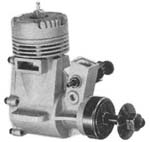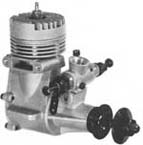Evolution History of the Fox
.29, .36, & .40 C-Frame Engine Series
Although the old, ringed, B-Frame .40BB was among the most potent .40 size engines of it's day, it was also larger and heavier than many of the increasingly popular imports. Engines like the OS .40FSR and HP .40 began to rival the Fox in power, and were also are smaller and lighter. In the early 1980's Duke Fox responded to this import invasion with a new .40 based upon his highly successful .36 Combat Special control line engine. The crankcase was modified to include muffler mounting lugs, and lengthened to allow space for an MKX type RC carburetor. The unusual square intake stack employed on the Combat Special was retained making the heritage of the new, C-Frame, "Compact 40" quite evident to Fox followers.


.36 Combat Special |


Compact .40 |
You can always count on Duke to try something different though. While retaining a rear ball bearing, the front of the crankshaft was left to run in the aluminum crankcase. No front ball bearing or bronze bushing! Perhaps this was done so he could still call this a ball bearing engine while reducing weight and cost (original advertisements did refer to it as a .40BB). Whatever the reason, this concept did not work out too well. It soon became evident that this configuration was not durable enough as the aluminum front bushing would quickly gall. It didn't take long before the new .40 included a front ball bearing as well.
Since the Combat Special was available in both .29 and .36 displacements, it's not too surprising that the new Compact Series RC engines also included these options. Like the .40, the .36 was upgraded to include a front ball bearing, but to our knowledge, the .29 never was. Unlike the .40, the .29 and .36 never did develop much of a following and only remained in production a few years.
Around about the mid 80's, Duke began experimenting with ABC construction. Up to that point, Fox engines had employed lapped iron, or ringed aluminum pistons. Being Duke, you gotta' know that when he applied the ABC concept to the new C-Frame .40, he'd be trying something different, and boy did he ever! As it turned out, his first ABC pistons were actually of composite construction with an iron band bonded to the top of an aluminum piston. The iron band, with better oil retention qualities, was supposed to provide better lubrication and cooling. If you look closely at the following cutaway picture (from an early Fox advertisement), you can see the composite piston construction:

Very early Fox .40ABC with composite iron / aluminum piston |
Well, this initial configuration was also very short lived and it's not too hard to guess why. The composite piston could not stand up to the operating environment and the iron and aluminum components tended to part company! Duke then returned to more conventional ABC construction and a much more successful engine.
By the late 80's the C-Frame engine series had been pared down to include an economy Bushing .40 (with bronze bushing), a Standard .40BB (with dual ball bearings), and a .40ABC Delux (with dual ball bearings). Along the way though, there were some confusing changes in model names and references. For example, the original single bearing Compact .40 was often referred to as the .40BB, but so was the earlier, larger, B-frame .40. As well, the current Standard .40 is often referred to as a .40BB. When the front bearing was first added to the Compact .40, Fox sold it with an aluminum spinner and referred to this combination as the .40 Delux. However, when the ABC version was introduced it was also referred to as the .40 Delux, so now history shows two .40 Delux engines, one with an iron piston and the other ABC. Since it's conception, this engine series has been referred to as the "Compact Series", "Series 6" and C-Frame Series". Sure makes it difficult to know what the heck is going on if you're not really familiar with these engines and their history.
Although the series has evolved into a stable and reliable configuration, there were a number of annoying operational problems along the way. For more information on these, and how to correct them, check out our page on "Getting the best from your Fox .40".
|